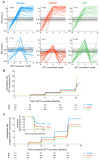Prevention of M. tuberculosis Infection with H4:IC31 Vaccine or BCG Revaccination
- PMID: 29996082
- PMCID: PMC5937161
- DOI: 10.1056/NEJMoa1714021
Prevention of M. tuberculosis Infection with H4:IC31 Vaccine or BCG Revaccination
Abstract
Background: Recent Mycobacterium tuberculosis infection confers a predisposition to the development of tuberculosis disease, the leading killer among global infectious diseases. H4:IC31, a candidate subunit vaccine, has shown protection against tuberculosis disease in preclinical models, and observational studies have indicated that primary bacille Calmette-Guérin (BCG) vaccination may offer partial protection against infection.
Methods: In this phase 2 trial, we randomly assigned 990 adolescents in a high-risk setting who had undergone neonatal BCG vaccination to receive the H4:IC31 vaccine, BCG revaccination, or placebo. All the participants had negative results on testing for M. tuberculosis infection on the QuantiFERON-TB Gold In-tube assay (QFT) and for the human immunodeficiency virus. The primary outcomes were safety and acquisition of M. tuberculosis infection, as defined by initial conversion on QFT that was performed every 6 months during a 2-year period. Secondary outcomes were immunogenicity and sustained QFT conversion to a positive test without reversion to negative status at 3 months and 6 months after conversion. Estimates of vaccine efficacy are based on hazard ratios from Cox regression models and compare each vaccine with placebo.
Results: Both the BCG and H4:IC31 vaccines were immunogenic. QFT conversion occurred in 44 of 308 participants (14.3%) in the H4:IC31 group and in 41 of 312 participants (13.1%) in the BCG group, as compared with 49 of 310 participants (15.8%) in the placebo group; the rate of sustained conversion was 8.1% in the H4:IC31 group and 6.7% in the BCG group, as compared with 11.6% in the placebo group. Neither the H4:IC31 vaccine nor the BCG vaccine prevented initial QFT conversion, with efficacy point estimates of 9.4% (P=0.63) and 20.1% (P=0.29), respectively. However, the BCG vaccine reduced the rate of sustained QFT conversion, with an efficacy of 45.4% (P=0.03); the efficacy of the H4:IC31 vaccine was 30.5% (P=0.16). There were no clinically significant between-group differences in the rates of serious adverse events, although mild-to-moderate injection-site reactions were more common with BCG revaccination.
Conclusions: In this trial, the rate of sustained QFT conversion, which may reflect sustained M. tuberculosis infection, was reduced by vaccination in a high-transmission setting. This finding may inform clinical development of new vaccine candidates. (Funded by Aeras and others; C-040-404 ClinicalTrials.gov number, NCT02075203 .).
Conflict of interest statement
TJS and MH report grants from Aeras. RR was a Sanofi Pasteur employee. SG and CADG are employees and share-holders at Sanofi Pasteur.
PA and IK report annual fees and milestone payments from Sanofi Pasteur and collaboration with Aeras and SATVI in other TB vaccine trials. PA has a patent WO2010/006607 "Vaccines comprising TB10.4" with royalties paid from Sanofi Pasteur to SSI.
TE, BL, DAH were employed by Aeras during the trial. KTR, RH and AMG report grants from Bill and Melinda Gates Foundation, grants from UK DFID, trial co-funding and in-kind support from Sanofi Pasteur, grants from DGIS (Dutch Government), during the conduct of the study; trial co-funding and in-kind support from GSK, outside the submitted work.
EN, HG, VR, FR, NB, SM, LM, ME, AT, HM, LGB, WAH, SGS, RDE have nothing to disclose.
Figures



Comment in
-
H4:IC31 Vaccine or BCG Revaccination for Tuberculosis.N Engl J Med. 2018 Nov 15;379(20):1969. doi: 10.1056/NEJMc1811046. N Engl J Med. 2018. PMID: 30428296 No abstract available.
Similar articles
-
A phase 1b randomized study of the safety and immunological responses to vaccination with H4:IC31, H56:IC31, and BCG revaccination in Mycobacterium tuberculosis-uninfected adolescents in Cape Town, South Africa.EClinicalMedicine. 2020 Mar 18;21:100313. doi: 10.1016/j.eclinm.2020.100313. eCollection 2020 Apr. EClinicalMedicine. 2020. PMID: 32382714 Free PMC article.
-
Safety and immunogenicity of the novel H4:IC31 tuberculosis vaccine candidate in BCG-vaccinated adults: Two phase I dose escalation trials.Vaccine. 2017 Mar 14;35(12):1652-1661. doi: 10.1016/j.vaccine.2017.01.055. Epub 2017 Feb 17. Vaccine. 2017. PMID: 28216183 Clinical Trial.
-
Adenovirus type 35-vectored tuberculosis vaccine has an acceptable safety and tolerability profile in healthy, BCG-vaccinated, QuantiFERON(®)-TB Gold (+) Kenyan adults without evidence of tuberculosis.Vaccine. 2016 May 5;34(21):2430-2436. doi: 10.1016/j.vaccine.2016.03.069. Epub 2016 Mar 26. Vaccine. 2016. PMID: 27026148 Clinical Trial.
-
[Novel vaccines against M. tuberculosis].Kekkaku. 2006 Dec;81(12):745-51. Kekkaku. 2006. PMID: 17240920 Review. Japanese.
-
Current status of new tuberculosis vaccine in children.Hum Vaccin Immunother. 2016 Apr 2;12(4):960-70. doi: 10.1080/21645515.2015.1120393. Epub 2016 Mar 22. Hum Vaccin Immunother. 2016. PMID: 27002369 Free PMC article. Review.
Cited by
-
The TB vaccine clinical trial centre directory: An inventory of clinical trial centres in Sub-Saharan Africa.PLoS One. 2024 Oct 28;19(10):e0292981. doi: 10.1371/journal.pone.0292981. eCollection 2024. PLoS One. 2024. PMID: 39466768 Free PMC article.
-
The effect of BCG revaccination on the response to unrelated vaccines in urban Ugandan adolescents (POPVAC C): an open-label, randomised controlled trial.Lancet Glob Health. 2024 Nov;12(11):e1849-e1859. doi: 10.1016/S2214-109X(24)00282-1. Lancet Glob Health. 2024. PMID: 39424573 Free PMC article. Clinical Trial.
-
DNA and RNA vaccines against tuberculosis: a scoping review of human and animal studies.Front Immunol. 2024 Oct 3;15:1457327. doi: 10.3389/fimmu.2024.1457327. eCollection 2024. Front Immunol. 2024. PMID: 39421744 Free PMC article. Review.
-
Advances in the development of new vaccines for tuberculosis and Brazil's role in the effort forward the end TB strategy.Mem Inst Oswaldo Cruz. 2024 Oct 4;119:e240093. doi: 10.1590/0074-02760240093. eCollection 2024. Mem Inst Oswaldo Cruz. 2024. PMID: 39383403 Free PMC article.
-
The BCG vaccine and SARS-CoV-2: Could there be a beneficial relationship?Heliyon. 2024 Sep 19;10(18):e38085. doi: 10.1016/j.heliyon.2024.e38085. eCollection 2024 Sep 30. Heliyon. 2024. PMID: 39347386 Free PMC article. Review.
References
Publication types
MeSH terms
Substances
Associated data
LinkOut - more resources
Full Text Sources
Other Literature Sources
Medical
